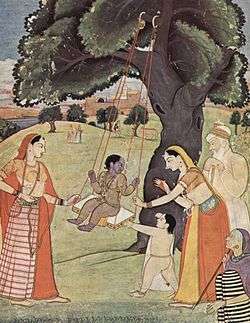Nanda Baba

Nand (also known as Nanda Gopa or Nanda Baba), according to the Harivamsha and the Puranas, was the head of the Gopas, a tribe of cowherds referred as Holy Gwals. He is popularly known as the foster-father of Krishna.[1]
Nanda was the Chief or Mandaladhish of Gokul Mandal that was one of the most powerful branches of Yadavas.[2] Vasudeva, took his new-born son Krishna to Nanda on the night of the child's birth so that Nanda could raise him. Nanda, who was married to Yasoda, brought up both Krishna and Balarama. Krishna derives his name Nandanandana (meaning son of Nanda) from him.[3][4]
Nanda was brother (cousin)[5] of King Vasudeva.[2][6]
Nanda's story
King Nanda
Nandagopa was the father of Goddess Durga(Yogamaya) and adopted father of Lord Sri Krishna. He took care of his sister Rohini's son Balrama. Nanda, also identified as King Nanda in many scriptures[7][8] was a kinsman and great friend of King Vasudeva.[9]
Krishna and Nanda
According to Bhagavata Purana, King Nanda of Gokul Kingdom was stepbrother of King Vasudeva.[10]
King Vasudeva married Devaki, the niece of King Ugrasena of Mathura. Devaki's cousin, an evil tyrant named Kamsa, had imprisoned Ugrasena and usurped the throne. Owing to the divine prediction that Kamsa would be slain by the eighth child of devaki, Kamsa arranged that all of Devaki's sons should die at birth.[7] Six children thus perished. But the seventh child was magically transferred in to the womb of Rohini,[11] Vasudeva's another wife living under care of King Nanda, and the child so born was Balrama, Krishna's elder brother. Krishna himself was placed by Vasudeva into the hands of Nanda. Both Krishna and Balrama were brought up by Nanda, the cowherd chief and his wife Yashoda.[12][13]
Nanda Gopeshwar
Nanda Gop once came to visit Shuklatirth. On the way back, he worshiped Koteshwara Shiva daily with ten crore crown flowers. After some time, Shiva was pleased and admitted Nanda into the ranks of his Gana and he became Gopeshwara.[14]
Nanda Memorials

Nandagaon
Nandagaon is one of the religious places near Barsana in Braj. It was capital of feudal Nanda Baba, where he resided with his followers and the cowherds.[15]
Nanda Bhawan (Chaurasi Khamba Mandir)
The residence of Nanda, known as Nanda Bhawan, where Krishna grew up and spent first three years of his childhood is main and most famous temple in Mahavan. This yellow coloured building having lots of wall paintings depicting pastimes of Krishna has 84 pillars inside. It is believed that there are 84,00,000 species in this material world and each pillar is said to symbolise 100,000 species, thus representing all the life in the universe.[16]
Nanda Ghata
Nanda Ghata is situated on the bank of sacred river Yamuna. The Ghata (River bank) is related to the rescue of Nanda Baba's abduction by the followers of God Baruna, while Nanda was taking bath in holy river Yamuna.[17]
See also
References
- ↑ His Divine Grace A. C. Bhaktivedanta Swami Prabhupad. Krsna, the Supreme Personality of Godhead- Chepter-5. The Bhaktivedanta Book Trust. ISBN 978-9171495587.
- 1 2 Gopal Chowdhary (2014). The Greatest Farce of History. Partridge Publishing. p. 119. ISBN 978-1482819250.
- ↑ John Stratton Hawley (2014). At Play with Krishna: Pilgrimage Dramas from Brindaran. Princeton Legacy Library: Princeton University Press. p. 316. ISBN 978-1400859122.
- ↑ Charles Barnett (2014). Blazing Sadhus or Never Trust a Holy Man Who Can't Dance. Charles Barnett,. pp. III. ISBN 978-1632958624.
- ↑ Sanghi, Ashwin (2012). The Krishna key. Chennai: Westland. p. Key7. ISBN 9789381626689. Retrieved 9 June 2016.
- ↑ Lok Nath Soni (2000). The Cattle and the Stick: An Ethnographic Profile of the Raut of Chhattisgarh. Anthropological Survey of India, Government of India, Ministry of Tourism and Culture, Department of Culture, Delhi: Anthropological Survey of India, Government of India, Ministry of Tourism and Culture, Department of Culture, 2000 Original from the University of Michigan. p. 16. ISBN 978-8185579573.
- 1 2 Renu Saran (2014). Lord Krishna: Gods & Goddesses in India. Diamond Pocket Books Pvt Ltd. ISBN 978-9351651826.
- ↑ Carl Woodham (2011). A God Who Dances: Krishna for You. Torchlight Publishing. pp. 95,99,103,104. ISBN 978-0981727363.
- ↑ Prem ságar; or, The ocean of love. Oxford University. 1867. p. 18.
- ↑ Carl Woodham (2011). A God Who Dances: Krishna for You. Torchlight Publishing. p. 96. ISBN 978-0981727363.
- ↑ Carl Woodham (2011). A God Who Dances: Krishna for You. Torchlight Publishing. p. 84. ISBN 978-0981727363.
- ↑ Carl Woodham (2011). A God Who Dances: Krishna for You. Torchlight Publishing. pp. 103–121. ISBN 978-0981727363.
- ↑ Winthrop Sargeant, Christopher Key Chapple (1984). The Bhagavad Gita: Revised Edition. SUNY Press. pp. 9, 14. ISBN 978-0873958318.
- ↑ Jürgen Neuß (2012). Narmad?parikram? - Circumambulation of the Narmad? River: On the Tradition of a Unique Hindu Pilgrimage Volume 42 of Brill's Indological Library. BRILL. p. 265. ISBN 978-9004228573.
- ↑ Trilochan Dash (2012). Krishna Leeela in Brajamandal a Retrospect. Saudamini Dash. p. 196.
- ↑ Dev Prasad (2010). Krishna: A Journey through the Lands & Legends of Krishna. Jaico Publishing House. ISBN 978-8184951707.
- ↑ Trilochan Dash (2012). Krishna Leeela in Brajamandal a Retrospect. Saudamini Dash. p. 211.
- Dictionary of Hindu Lore and Legend (ISBN 0-500-51088-1) by Anna Dallapiccola
